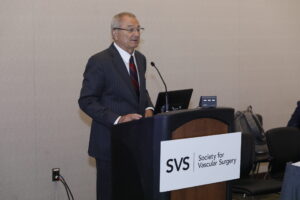
The question of “persistent problems” with venous stenting among post-thrombotic syndrome (PTS) patients emerged as a key talking point during the recent Deep Venous Stenting Summit that took place during VAM 2023 in National Harbor, Maryland (June 14–17).
The issue was raised by venous disease titan Peter Gloviczki, MD, professor and chair emeritus of vascular surgery at the Mayo Clinic in Scottsdale, Arizona, after a talk by Erin Murphy, MD, director of Sanger Heart & Vascular Institute’s venous and lymphatic program in Charlotte, North Carolina, drilled into the management of stent complications—pondering whether to recanalize, explant or bypass.
Prior speaker, Mark D. Iafrati, MD, a professor of vascular surgery at Vanderbilt University Medical Center in Nashville, Tennessee, had in a prior talk on best medical treatment and surveillance protocols already provided the data behind Gloviczki’s point—published in 2013 in the Journal of Vascular Surgery by Seshadri Raju, MD, a vascular surgeon at the Rane Center in Jackson, Mississippi, and colleagues showing 90–100% patency in the setting of non-thrombotic disease and 74–89% in PTS at three to five years, outcomes which he said hold up today.
“Dr. Raju’s results are excellent, but let’s face it, about one-in-four post-thrombotic patients has problems with stents, and there are persistent problems,” Gloviczki commented from the floor during a question-and-answer session at the close of the summit. “One, for instance, is if you have a lesion very close to the IVC [inferior vena cava].
“We really don’t have a beveled stent in this country,” he continued, referring to the CE-marked sinus-Obliquus device. “Even the dedicated stents extend, at least in part, in these patients into the vena cava. So, I wanted to ask Erin if you still use the technique of combined stenting and have you had problems with the penetration of the wall by the Z-stent?”
Murphy related her early experience navigating venous dedicated stents to her intended landing spot.
“With the newer stents, I had a little bit of trouble at first trying to get them to land right at the cava and treat the cranial disease right there to the point where I almost went back to combined stenting with Z-stents,” she explained. “I’ve since fairly-well perfected landing them without jailing the other side. They are strong enough that, even if the artery is right there, they don’t collapse like the Wallstent does—it pushes the artery off, and I have not had recurrence.”
It is a different story among already-stented patients who land in Murphy’s practice, she continued. “I do see quite a bit of universal jailing of the other side. Most patients who I see in my practice that have already been stented, [the other side] is jailed. We are still pretty early—with the old stents it took us 10–15 years to say that it is a problem. I do think we have seen a couple of contralateral [deep vein thromboses] to the new stents, so I do think it will happen. And if it inadvertently happens, I encourage those patients, or If I see somebody sent [my way], I encourage them to be on low-dose anticoagulation.”
In terms of Z-stents, Murphy elaborated that she had not encountered them outside the IVC, explaining: “Typically, the ones that I’ve done in the past were inside—three quarters of them—the Wallstent, so that kind of prevents [penetration], but in the cases where they are unsupported, I have seen them outside the cava. I have not had complications from them.”
Gloviczki further pondered the specter of the external iliac vein. “We never talk about it but most of the time we stent into the external iliac vein, and mostly we do so because some of the common iliac veins are so big, but practically every time we jail the internal iliac vein, and I wonder if in the long run this is not going to be an issue.”
Murphy referred to the use of Wallstents in this setting over the years. “I don’t recall seeing a consequence of that,” she noted. “The internals are so well collateralized, but maybe we’re just not looking.”
Fellow panelist Lorena DeMarco-Garcia, MD, chief of vascular surgery at Plainview Hospital, Northwell Health in Syosset, New York, who spoke on stenting for non-thrombotic iliac vein lesions (NIVLs), concurred, saying: “The pelvic floor drains contralaterally and that is it. But I’m sure we are probably eventually causing future ostium occlusion, for sure.”












